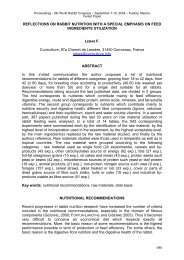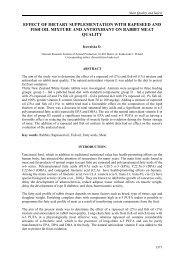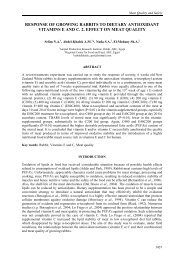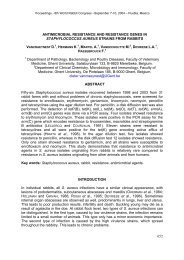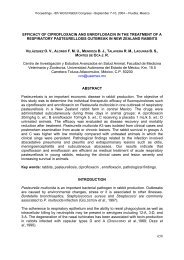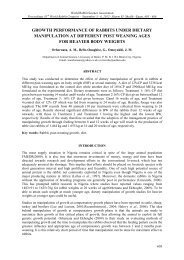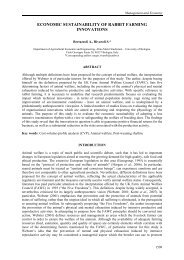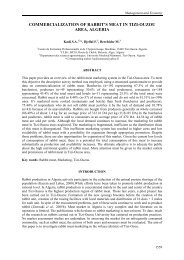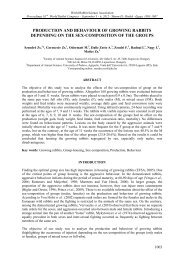characterization of traditional rabbit breeding system used
characterization of traditional rabbit breeding system used
characterization of traditional rabbit breeding system used
Create successful ePaper yourself
Turn your PDF publications into a flip-book with our unique Google optimized e-Paper software.
9 th World Rabbit Congress – June 10-13, 2008 – Verona – Italy<br />
1- A questionnaire on animals and their behavior. The data collected foc<strong>used</strong> on:<br />
• Environment interaction with management<br />
• Livestock <strong>system</strong><br />
• The animal populations managed<br />
• The number <strong>of</strong> males, females and young animals<br />
• Animal housing<br />
• Feeding <strong>system</strong><br />
• The reproduction <strong>system</strong><br />
• Health and sanitary status<br />
• Management results<br />
• Marketing <strong>system</strong>s.<br />
2- Illustration with taking photos <strong>of</strong> the various animal phenotypes and the raising sites<br />
Counted data<br />
The survey covered 199 <strong>rabbit</strong> breeders. The classification <strong>of</strong> the <strong>breeding</strong> <strong>system</strong>s was based on<br />
housing, food and the animals' reproduction <strong>system</strong>.<br />
Breeders’ distribution<br />
1506<br />
RESULTS AND DISCUSSION<br />
The breeder’s distribution was surveyed by delegation and recorded in Tables 1 and 2.<br />
Table 1: Rabbit breeders’ distribution among delegations in the governorate <strong>of</strong> Tozeur<br />
Delegation Number %<br />
Nefta<br />
Hazoua<br />
Tamarza<br />
Dguech<br />
Tozeur<br />
Total 171 100<br />
Table 2: Rabbit breeders’ distribution among delegations in the governorate <strong>of</strong> Gafsa<br />
Delegation Number %<br />
Gafsa<br />
El Guettar<br />
El Ksar<br />
Sidi Aïch<br />
El Snad<br />
Total 28 100<br />
Livestock classification <strong>of</strong> various <strong>system</strong>s<br />
31<br />
13<br />
29<br />
65<br />
33<br />
7<br />
6<br />
5<br />
4<br />
6<br />
18.12<br />
7.6<br />
16.95<br />
38.01<br />
19.29<br />
25.0<br />
21.4<br />
17.85<br />
14.28<br />
21.4<br />
The livestock <strong>system</strong>s encountered in the study area are divided into two types: the non improved<br />
livestock <strong>system</strong> and improved livestock <strong>system</strong>.<br />
1- The non improved livestock <strong>system</strong><br />
a) Housing<br />
According to the results, it was noticed that in this <strong>system</strong> <strong>of</strong> management <strong>breeding</strong> <strong>used</strong> is specially<br />
conducted in full colony. This <strong>system</strong> <strong>of</strong> management is intended to satisfy the family autoconsumption,<br />
the parents and their descendants are not separated, males and females are permanently<br />
mating in free open reproduction <strong>system</strong>. The females are more likely to be mated when they are in<br />
estrus.





